E-Museum of Pyrographic ArtAntique Art Hall
|
| - Café Flambé - | - Portraits and Paintings - | - Decorative and Applied Art - |
| - Folk and Traditional Art - | - Antique Art - | - Special Hall - | - Sculpture - |
| - Children's Hall - | - Bookstore and Library - | - Tools and Techniques - |
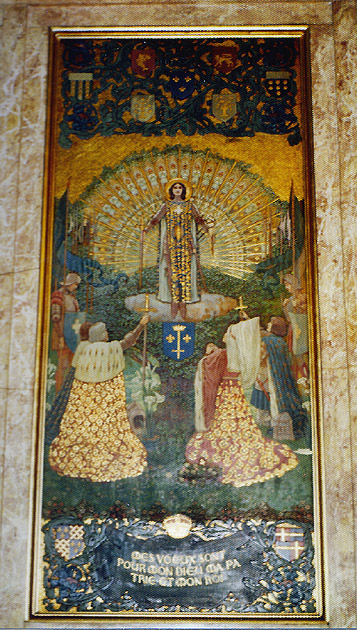 |
| Glorification of Jeanne d'Arc (Fifth panel of a pentaptych of the life of St. Joan of Arc) By J. William Fosdick, circa 1915 Pyroengraving, gilding, and color on framed wood panel, embedded along with four companion panels in the marble wall in the Catholic Church of St. Joan of Arc, Jackson Heights, Long Island, New York, U.S.A. Photograph by John P. Lewis, © 1979 |
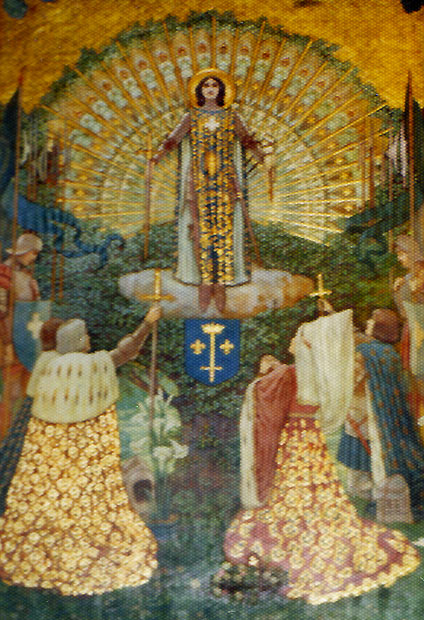 |
| Glorification of Jeanne d'Arc, detail (Fifth panel of a pentaptych of the life of St. Joan of Arc) By J. William Fosdick, circa 1915 Pyroengraving, gilding, and color on framed wood panel, embedded along with four companion panels in the marble wall in the Catholic Church of St. Joan of Arc, Jackson Heights, Long Island, New York, U.S.A. Photograph by John P. Lewis, © 1979 |
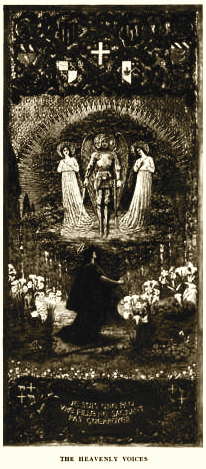 |
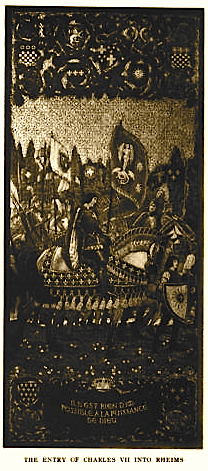
|
Two of Five Panels
of the pentaptych of the life of St. Joan of Arc
By J. William Fosdick, circa 1915
Pyroengraving, gilding, and color on framed wood panel
From the article by W. Laurel Harris, linked below.
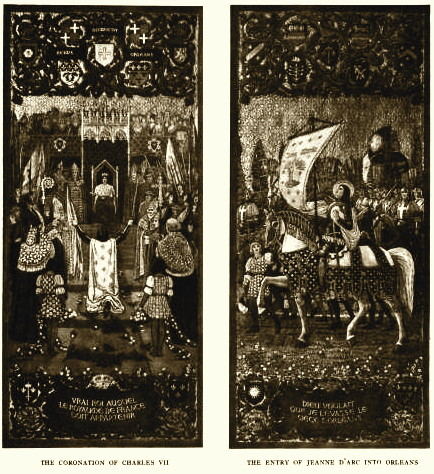 |
Two of Five Panels
of the pentaptych of the life of St. Joan of Arc
By J. William Fosdick, circa 1915
Pyroengraving, gilding, and color on framed wood panel
From the article by W. Laurel Harris, linked below.
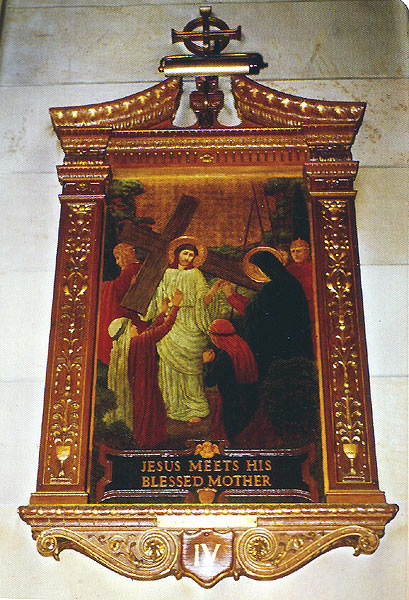 |
| Jesus Meets His Blessed Mother, Via Crucis, Station IV (one station of 14 Stations of the Cross) By J. William Fosdick Pyroengraving, gilding, and color on framed wood panel, in the Catholic Church of the Immaculate Conception, Waterbury, Connecticut, U.S.A. Photograph by John P. Lewis, © 1979 NEWSFLASH! 8 December 2009: Link here to an exhibit of all of Fosdick's Stations of the Cross. |
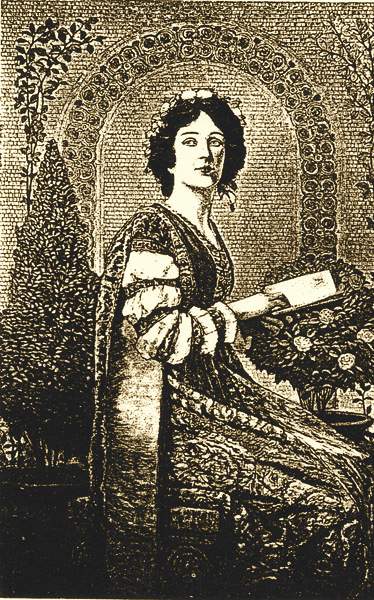 |
| The Venetian Reader* By J. William Fosdick Pyroengraving and color on a framed wood panel Collection of the Yaddo Estate Saratoga Springs, New York, U.S.A. Adapted from a black+white illustration in a July 1914 article in Arts and Decoration magazine * Also referred to as The Florentine Reader in another account of that time. |
American artist J. William Fosdick (1858–1937) made his career primarily by doing large works on commission for interior architects of important estates and buildings. His first important commission occurred while he was still a student at the Académie Julian in Paris from 1881 to 1888. He postponed his studies and returned to the United States in 1884 for that important job, which utilized his then unique skills as a pyrographic artist. His recommendation for that first job, which launched his very successful career in this technique, came from none other than the widow of his predecessor Robert Ball Hughes. The three works shown here were later ones, done in the early 20th Century.
Some notes from John P. Lewis describe the phases of Fosdick's technique and style:
"As a Bostonian, he was acquainted with Ball Hughes' poker drawings. Fosdick studied at the Julian Academy in Paris from 1881 to 1888 after attending the Museum of Fine Arts School in Boston.
Using his extensive training in painting and drawing as well as his knowledge of European history, Fosdick developed his own decorative style and subject matter. He worked on a large scale and decorated altars, friezes, walls, and mantels in churches and private homes. His technique, which earned him the honor of being the father of fire-etching in America, was to burn the design, gouge relief features, char again, and gild highlighted areas. . .
Later, Fosdick's style changed to what he described as "incised line painting." His series of fourteen panels, "The Stations of the Cross," in the Church of the Immaculate Conception in Waterbury, Connecticut, exemplified his shift in emphasis from gouging to painting and gilding.
— John P. Lewis, © 1979
The first work (in two views above) is one framed panel (the fifth) in a set of five of the life of St. Joan of Arc, ultimately acquired for the church of St. Joan of Arc in Jackson Heights, in the Roman Catholic Diocese of Brooklyn, New York, where they remain today. The more recently added four small images that follow those are adapted from the illustrations in the W. Laurel Harris article linked following.
NEWSFLASH! September 2008: Recently discovered is an excellent illustrated article from 1915 by W. Laurel Harris entitled
A PENTAPTYCH BY J. W. FOSDICK, which displays images of all of the five panels and discusses Fosdick's work and technique in detail.
In the following excerpt from a December 1915 Boston newspaper report, the subjects of the five panels are described for an exhibit of Fosdick's works at Boston's historic St. Botolph Club:
"The first panel represents "The Heavenly Voices" and the apparition to the Maid of the three saints, Michael, Margaret, and Catherine. The second panel has for its subject, "The Entry of Charles VII into Rheims. " The third panel depicts "The Coronation of Charles VII at Rheims." In the fourth panel we witness "The Entry of Jeanne d'Arc into Orleans." Finally, the fifth panel is devoted to "The Glorification of Jeanne d'Arc." Under each composition of figures is a quotation in French from the words of the heroine; and at the top of the upright panel is a conventionalized design in which the coats of arms of the ancient provinces of France are introduced."
With a similar composition to the panel from the pentaptych shown here—but done in his earlier technique of burning and gouging—is a magnificent 1896 triptych also by J. Wm. Fosdick of the Glorification of Joan of Arc, which is in the American Art Museum of the Smithsonian in Washington, D.C., U.S.A. Note also that in the center at the bottom of their respective panels, both works bear her famous quotation: "Mes derniers voeux, ma dernière pensée sont pour mon Dieu, ma patrie, et mon roi." ("My last wishes, my last thought are for my God, my country, and my king.") However, the panel from the pentaptych has an abbreviated version of it: "Mes voeux sont pour mon Dieu, ma patrie, et mon roi." ("My wishes are for my God, my country, and my king.")
In a second newspaper article in Boston—dated December 12, 1915—announcing J. William Fosdick's exhibit at the St. Botolph Club, as well as his speaking engagement at the Copley Society of Boston of which he was also a member, there is a very nice description of the five panels, as follows:
"With wonderfully intricate and yet logically ordered display of ancient symbols and heraldic ornamentations laid in color, gold and silver upon a groundwork of basswood, the panels depict five of the most dramatic incidents in Jeanne d'Arc's career. In the first she listens to the celestial voices. The second shows the entrance into Rheims, with Charles VII riding in, surrounded by courtiers, soldiers and men-at-arms. The central panel...represents Jeanne at the coronation in the Rheims cathedral (lately ruined by the modern Goths). She kneels among cardinals, princes and prelates, a white-robed figure with upturned sword. The fourth picture represents the inspired general leading her troops into the beleaguered town of Orleans. In the fifth appears the "Glorification of Jeanne d'Arc," in which the warrior saint comes in a vision before kneeling bishops, kings, courtiers and men-at-arms, bearing on her breast a cross of white as symbol of her conquest over the death that conquered her.
These panels, elaborated with very wonderful artistry and scholarship, should prove one of the very important exhibitions of the present season in Boston. During his stay here Mr. Fosdick will give an illustrated lecture on Jeanne d'Arc before the Copley Society."
Also worthy of mention is that the first of the two newspaper articles reported that there were nearly thirty additional works by J. William Fosdick being exhibited at St. Botolph Club along with the pentaptych of Jeanne d'Arc,
"...including a capital series of three panels intended for the grill room of the National Arts Club, New York, a group of three Flemish heads for an over-mantel, a group of three portraits of Queen Elizabeth for an over-mantel, "The Florentine Reader" [sic] lent by Mrs. Spencer Trask, and about a score of minor single subjects."
The second exhibit in this salon, Jesus Meets His Blessed Mother is Station IV of fourteen Stations of the Cross from the Catholic Church of the Immaculate Conception in Waterbury, Connecticut.
NEWSFLASH! 8 December 2009: Link here to an exclusive exhibit of all of Fosdick's Stations of the Cross by photographer Sharon H. Garvey in 2008.
It is interesting that the three works in the above exhibit are colored, because, in his earlier articles dated 1891, 1894, and 1896 (see the Fosdick section in the Antique Hall here in the E-Museum), Fosdick emphasized the importance of avoiding color in "burnt wood" works.
NEWSFLASH! April 2009: At this link is an excerpt from an excellent illustrated article from 1909 by J. Wm. Fosdick himself entitled
FIRE ETCHING IN HOME DECORATION. In his own words, the artist offers a detailed description of his work and 20th C. color technique.
The third exhibit, the panel of The Venetian Reader (also referred to as "The Florentine Reader" in one account) is shown above in a digital image adapted from a black-and-white illustration in a July 1914 article entitled "The Decorations of a Gothic Studio: The New York Home of J. William Fosdick" by Ada Rainey in the Arts and Decoration magazine, pp. 341–343. We know that the panel is colored from the accompanying text describing it in that article. That work is from the summer estate, called Yaddo of the late financier Spencer Trask and his wife Katrina, who was a poet. Unfortunately, the registrar at Yaddo has no knowledge of this work in that collection today. The following brief history is from the Yaddo web site:
"Over 100 years ago Spencer and Katrina Trask—through their last will and testament—bequeathed Yaddo to future generations of writers, composers, painters, and other creative artists. This inspired bequest resulted in an extraordinary legacy, with thousands of artists from America and abroad benefiting from residencies at Yaddo." —Yaddo Corporation
If you have any questions or any information regarding these works by J. William Fosdick, please e-mail the E-Museum Curator.
Using his extensive training in painting and drawing as well as his knowledge of European history, Fosdick developed his own decorative style and subject matter. He worked on a large scale and decorated altars, friezes, walls, and mantels in churches and private homes. His technique, which earned him the honor of being the father of fire-etching in America, was to burn the design, gouge relief features, char again, and gild highlighted areas. . .
Later, Fosdick's style changed to what he described as "incised line painting." His series of fourteen panels, "The Stations of the Cross," in the Church of the Immaculate Conception in Waterbury, Connecticut, exemplified his shift in emphasis from gouging to painting and gilding.
These panels, elaborated with very wonderful artistry and scholarship, should prove one of the very important exhibitions of the present season in Boston. During his stay here Mr. Fosdick will give an illustrated lecture on Jeanne d'Arc before the Copley Society."
You are leaving the
J. William Fosdick Salon No. 2
You can return to the:
Antique Art Hall
or continue on your tour to one of the following
Pyrographic Art Exhibit Halls:
Portraits and Paintings
Decorative and Applied Art
Sculpture
Folk and Traditional Art
Children's Pyrographic Art
Special Pyrographic Art
The Book Store and E-Museum Library
Pyrography Tools and Techniques
Your questions and comments are welcome and appreciated.
Please e-mail Curator.
Back to E-Museum Entrance homepage
© 2007, 2008, 2009 Kathleen M. Garvey Menéndez, all rights reserved.
Last updated 17 December 2009.

